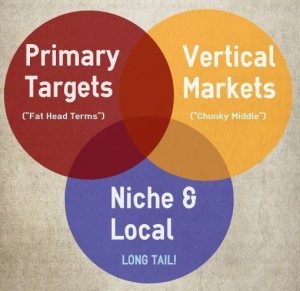
If you’ve ever researched SEO strategies or discussed keyword targeting strategies with your digital marketing team or SEO agency, you may have come across the phrase “Long Tail Keywords”.
Granted, this term might also be entirely new to you. Or perhaps you’ve heard it but you’re unsure of its meaning. Either way, any business owner on the web can undoubtedly benefit from a better understanding of Long Tail Keywords and what they mean for your online marketing strategies.
A Quick Reminder About Keyword Research
As a preface, remember that one of the key foundational steps toward optimizing your website for search engines involves Keyword Research. This process outlines a core group of keywords you’ll target during the SEO campaign.
These primary keywords should target your specific audience, leveraging the likelihood that your targeted audience will use those keywords in search engine queries and thereby find your site in the result pages.
What are Long-Tail Keywords?
Now that we’re clear on the fundamentals of Keyword Research, let’s look at what Long Tail keywords are and where they get the name ‘Long Tail’. We’ll go through some of the strategies surrounding these types of keywords as well.
When SEO marketers talk about Long-Tail Keywords, they’re usually referring to a group of ‘less obvious’ keywords; outliers in the general pool of primary keywords.
These keywords are usually a little more specific, often considered very ‘niche’ phrases and therefore applicable to a smaller scope of websites than their more generic (and more competitive) counterparts.
For example, a website targeting the keywords “children’s books” might also consider a Long-Tail Keyword phrase like “picture books for toddlers”.
Note that this phrase isn’t really that long of a query in terms of words. I point this out only to abate the common misconception that a query with a longer string of words in it is therefore considered Long-Tail, and that Long-Tail keyword phrases have to contain a lot of words to be considered as such. There is, in fact, a better explanation…
Why Do We Call Them “Long-Tail” Keywords?
In actuality, the term “Long-Tail” refers to a section of a chart commonly used to better visualize keyword strategy in graphic form. It all makes sense when we look at such an illustration, as seen below:

This is a graph of the global search demand curve. We’ll look into what this graph means for our keyword targeting strategies a bit later. Right now, we’re simply looking at the flat, grey colored portion noted as “Long Tail”.
Phrases falling into that section of the universal keyword pool are all considered “Long-Tail”, and that’s where the term originated.
Note that you hear many people use the term “Short Tail” in referring to the opposite of Long Tail keywords, but this is a bit of a misnomer. Instead, we prefer to group the rest of the higher competition, higher volume keywords into “Chunky Middle” and “Fat Head” categories (as denoted in the graph). So if you hear those terms, you’ll know what those are too!
One of the leading visionaries in the SEO industry, Rand Fishkin (former CEO of SEOMoz, now simply ‘Moz.com’) – who incidentally created the above graphic – once elicited a now famous warning to the web community in his video on the subject.
The warning: “Ignore the Long Tail at Your Peril”.
Sounds pretty serious, right? Most SEO professionals agree that indeed it is. Let’s look at the reasons for this important concern and how to apply what we’re seeing in the Search Demand Curve graphic.
Let’s start with our example from earlier, about the ‘picture books for toddlers’ keywords. We can surmise that such a phrase has a lower volume of people typing it into search engines than the obviously high-volume “children’s books” query.
Our illustration above would also reinforce this deduction, as this Long-Tail phrase would fall in the low end of search demand volume.
So if Long-Tail keywords have lower search volume (and thereby potentially less traffic), what’s so great about them? The short answer: Easier exposure to higher quality traffic.
Of course we certainly don’t want to ignore the ‘Fat Head’ or ‘Chunky Middle’ either, but the fact is that those targets tend to be obvious pursuits for most businesses. Long Tail keywords are neglected, if not entirely absent, in a surprising swath of campaigns.

A well-rounded marketing campaign will typically involve initial efforts to gain traction in the search results for high volume (and often more generic) keywords, but will supplement those efforts with smartly focused Long-Tail keyword targeting and optimization to maximize exposure, traffic potential and diversification.
Using Long-Tail keywords is essentially leveraging a trade-off in terms of targeting your audience on the web, but the high volume targets has its own share of trade-offs as well.
As we see in the Demand Curve graph, achieving positive ranking in the “Fat Head” and “Chunky Middle” arenas consistently puts us in front of hundreds of thousands of consistent searchers. The obvious benefit here is a high in-flow of traffic and exposure, so what’s the trade-off? High competition, frequently mismatched relevance and a hefty helping of low quality visits.
The trade-off when optimizing for Long-Tail keywords is basically a contrast to that of the high-volume targets. Instead of opening the floodgates to a deluge of visitors coming in from generic queries, you’re creating a carefully focused channel of qualified leads, although fewer visitors.
Long-Tail keywords have some additional perks as well, such as improving the user experience and the likelihood that visitors consider your website a good match for their query (Google loves this).
Let’s not forget that the ‘Long Tail’ represents a whopping 70% of all keywords! That section of keywords is the essence of diversification, affording a large pool of potential where you can add variety to your market share with less competition. Keyword targeting is an investment. The famous ‘first rule of investing’ is ‘diversify, diversify, diversify’, so how can you reasonably leave these out of your portfolio?
The Take-Away:
Long-Tail keywords represent a ‘no-brainer’ revenue stream. Because you are shrewdly engaging the stragglers in your industry’s audience, you’ll soon be scooping up gobs of money left on the table by your competitors who have ignored the Long-Tail (at their peril!).




